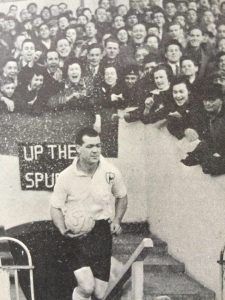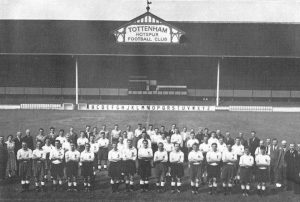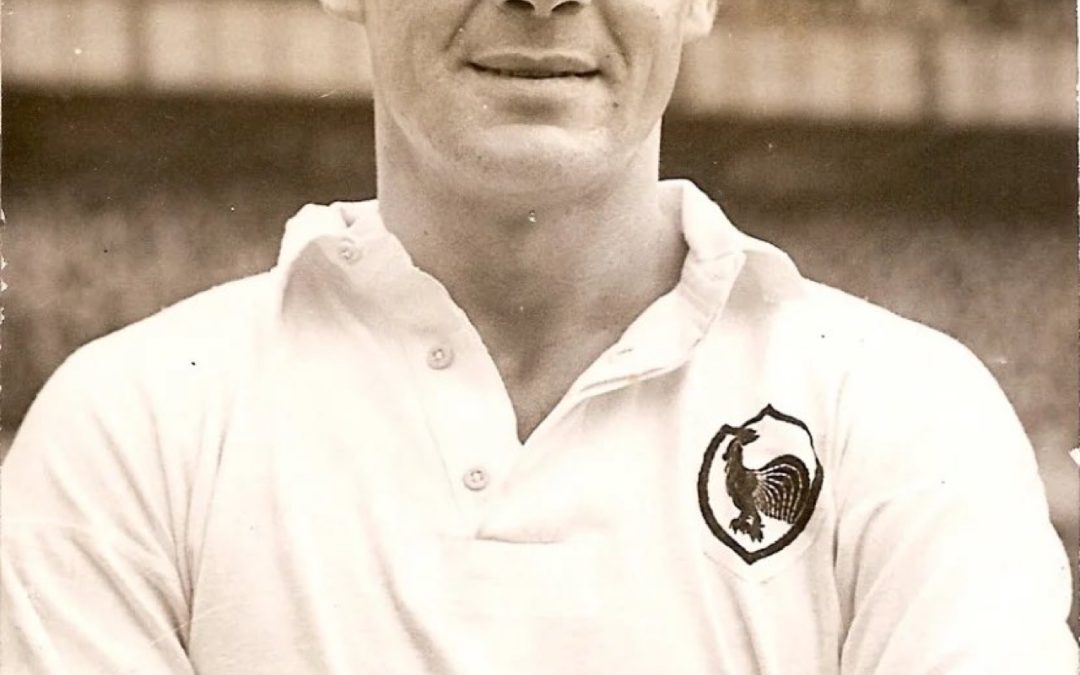BY Vince Cooper
FOOTBALLERS from the Channel Islands making it to the top of the game have been few and far between. Amazingly, Guernsey’s Matt Le Tissier and Jersey’s Graeme Le Saux, both born in 1968, made it all the way to full England recognition in the early 1990s whilst Dick Le Flem, whose parents were from Guernsey made an England Under-23 appearance in the 60s . These three were following a trail originally blazed by ‘The Duke’.
Leonard Stanley Duquemin was born in Cabo on the island of Guernsey in July 1924. After helping out in his brother’s building business, his first ‘outside’ job was as a gardener in a monastery during the German occupation in World War 2 and the fact that the monks were from France and didn’t speak English led to him becoming fluent in a second language.
As the war was coming to an end Len was playing for local side Vauxbelet where his performances saw him recommended to Spurs by lock man and Tottenham fan Ted Zebelia . Following a successful trial shortly after the war ended he joined Spurs as an amateur in December 1945 and was initially sent out on loan to Chelmsford City – then managed by Arthur Rowe – who he helped to win the Southern League. He also made one amateur appearance for his parent club, in the away draw at Fulham in the Football League (South) in March 1946
Returning to White Hart Lane for the 1946-47 season he turned professional in September but in October of that year tragedy struck. Len was set to play for Spurs reserves against Birmingham when he learned that his brother, Francis had drowned on his way over from Guernsey to see the match. Francis was tragically swept overboard whilst travelling on the steamer ‘Isle of Jersey’.
Len originally decided not to play before receiving a phone call from his other brother, Sidney, who insisted that he should take part in honour of their dead sibling. So he played and netted the winner the winner in a 2-1 victory.
The start of the 1947-48 season saw the start of The Duke’s Spurs first-team career. He made his official debut in the 2nd Division match against Sheffield Wednesday on 30 August, after being chosen by manager Joe Hulme to replace Charlie Rundle up front. His second start, against Bury, brought a first goal and, with 11 more by the end of October he quickly made the centre-forward spot his own with one reporter praising his ‘cucumber-cool football brain’.
By the end of that 1947-48 campaign Duquemin had bagged 24 goals as the team finished 8th in the 2nd Division. He also scored in the FA Cup semi-final at Villa Park but a Stan Mortensen hat-trick meant that it was opponents Blackpool who reached Wembley.
Despite that good season Joe Hulme never seemed entirely convinced about his centre-forward’s qualities and there was talk of Len leaving White Hart Lane in the late 1940s with a move to Cardiff in a swap for City’s Welsh international Billy Rees seemingly on the cards . Although the exchange never materialised Rees did move to North London for £14,000 and competed with The Duke for the number 9 shirt.

When Arthur Rowe came in to replace Hulme in 1949 there was initial competition between the two in the battle to lead the attack. But as the manager developed the famous ‘push and run’ style of play it was Duquemin’s hard-working style and unselfish attitude that proved the perfect fit. Rees soon became surplus to requirements and was sold to Leyton Orient with the club making a £500 profit on his purchase price.

The 2nd Division title-winning squad
After Spurs had romped to the 2nd Division title by nine points in the previous campaign, great things were expected for 1950-51 as Rose’s ‘push and run’ football continued to leave opponents floundering in its wake.
But the campaign started inauspiciously with a 4-1 home defeat to a Stanley Matthews-inspired Blackpool. Rowe’s men travelled to Bolton for their next match and the warning bells might well have been sounding when they fell a goal behind. But Spurs allayed any fears that their style might not work at the highest level, scoring four times without reply (Duquemin got the fourth) and they were on their way.
A run of eight successive wins from the end of September culminated in a 7-0 thrashing of eventual cup winners Newcastle United which pushed them up to second place behind Arsenal.
The Duke failed to find the net in that 7-0 win but scored regularly throughout the season, and none were more important than the one on April 28.

The Duke comes up against Allenby Chilton of Manchester United
Spurs had moved to the top of the table and entered the penultimate day’s match against relegation-bound Sheffield Wednesday three points clear of Manchester United.

Tottenham Hotspur 1950-51
The match was tight with Spurs showing the tension that comes from being so close to the title. But just before half-time, a brilliant run by Eddie Baily saw him lay the ball off to Les Medley. The inside-forward fed Duquemin who beat advancing Wednesday ‘keeper Dave McIntosh to give his team the lead.

Champions
The second half saw Wednesday have chances to get back into the game but Spurs held on to secure their first-ever title. The Duke finished the campaign with 14 goals in 34 starts, one behind leading marksman Medley.

Running out at the Lane
Whilst the centre-forward’s role is often personified as a tough, battling position with the player leading from the front and having something of the ‘devil’ about him, Duquemin was known throughout football as being one of the ‘nice guys’. ‘He is the finest fellow in football’, wrote Lee Norris in Soccer Star. ‘A fellow who gives this grand ol’ game the touch of the old-time gallantry that it deserves.
’Duquemin will never be one of the greats’, Norris continued. ‘He has not the streak that makes genius. He is sound, and being sound a Soccer certainty for success’.
Although he twice managed to reach the 24-goal mark at White Hart Lane those were the only times Duquemin led the goalscoring charts. But those who did finish as leading scorer, Les Bennett, Les Medley and Sonny Walters, as the team went from 5th in the 2nd Division to 1st Division champions in just three seasons, had The Duke to thank for many of their goals. Norris acknowledged this in his article, writing; ‘It would be useful if Soccer adopted the ice hockey technique and awarded assists for the man who made the goal. Duquemin would be high on the list at the end of a season’.
‘The Duke’ was the epitome of the ‘team man’ always working hard to put opposing defenders under pressure and using his strength to hold the ball up and bring others into the game. In fact he was perfectly suited to Arthur Rowe’s push and run style.
The ‘push and run’ was revolutionary at the time with the team advancing up the pitch with fast, short moves, one-twos and wall passes rather than the long-ball tactics prevalent at the time. ‘Make it accurate, make it simple, make it quick’ was the Rowe mantra and in Duquemin he found a perfect disciple.
With talented inside-forwards Les Bennett and Eddie Baily on either side of him, Duquemin was the willing work horse, holding off central defenders and bringing his teammates into the game. It had much more in keeping with the continental style employed by Austria and most famously Hungary in their thrashings of England in 1953 and 1954.
In that title-winning season a new challenger emerged for the centre-forward role with Sid McLellan, another who had used the Chelmsford City stepping-stone, pushing for a place in the side. In fact it seemed that The Duke’s place was constantly under pressure with Alfie Stokes, coming up through the system and Dave Dunmore signed from York City for £10,750 also pressing for the number nine shirt, but each time he was challenged Duquemin responded and made it almost impossible for Rowe to leave him out of the team.
In 1955 Rowe’s ongoing health issues forced him to step down from the manager’s role and long-time servant Jimmy Anderson who had originally joined the club’s groundstaff way back in 1908 stepped into the role.
Anderson, by then already well into his sixties, was a stop-gap whilst the club waited for Bill Nicholson, who had been appointed as first-team coach when Anderson moved into the hot seat, to take over, although he did lead the team to an FA Cup semi-final.
At the start of the 1955-56 season Anderson played both Dunmore and Duquemin up front but the writing was on the wall for The Duke when, In December 1955 the club paid £18,000 for youngster Bobby Smith from Chelsea.
The bull-like Smith, who went on to compile an excellent scoring record both for Spurs (176 goals in 271 games) and for England (winning 15 caps and scoring 13 times) ousted Duquemin from the starting line-up and finished the season with 13 goals from 27 games whilst The Duke made a total of 23 starts, scoring eight times.
Two of Duquemin’s goals came in the FA Cup quarter-final where Spurs overcame West Ham in an Upton Park replay. In the semi at Villa Park Anderson fielded The Duke, Smith and Dunmore but they failed to find a goal between them and the team fell to a single-goal defeat to eventual winners Manchester City.
Smith and Stokes combined for 38 strikes in the 1956-57 season, with the now 32-year-old Duquemin, now clearly in a back up role and making just two starts. He scored in a 3-1 win at Luton Town in February and where he reportedly ‘showed all his old verve’. But it proved to be his last goal for the club and he spent a year in the reserves before leaving for Southern Leaguers Bedford Town in November 1958 for £2,000 as part of a double deal with Colin Brittan.
Len left White Hart Lane having scored 114 goals in 274 league appearances with another 17 in 33 cup matches.
Duquemin, who had turned down a move to Millwall before joining Bedford, made his debut in a clash with Weymouth on November 22 and scored twice in a 5-2 win. A week later he netted two more at Cambridge City and would go on to notch 31 goals in 30 games as Bedford won the Southern League title.
In his second season at Bedford, the Duke scored 43 time in 54 games in all competitions to prove that he retained both his scoring touch and his durability but then he moved on again playing first for Hastings United and then Romford before ending his competitive career.

The Haunch of Venison
The boots were dusted down and brought out often with appearances for the Showbiz XI in charity matches during the 1960s while running his newsagent’s shop in Northumberland Park, Tottenham. He later took over as mine host at the Lord Nelson pub in Barnet then the wonderfully-named Haunch of Venison pub in Cheshunt High Street, not far from the Spurs training ground. After retiring he lived just a five-minute walk from White Hart Lane and often attended matches, sometimes alongside wife June, a Tottenham girl to whom he was married for 50 years.
Len Duquemin passed away in 2003 at the age of 78. Although perhaps just below the best at his craft, the Duke’s hard work ethic was perfectly suited to the new way of play Arthur Rowe introduced at Tottenham and his willingness to run for 90 minutes and unselfishness were greatly appreciated by teammates and fans alike.

